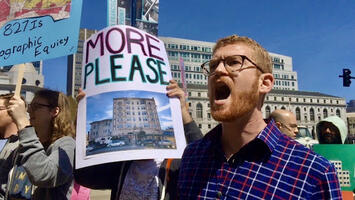
If you’ve read this blog over the years you know that I’ve increasingly written about a general staleness in urbanist discourse. I’ve characterized it as seeing a need for new ideas in urbanism discourse, superstar cities becoming the victims of their own success, or the needs of interior cities being glossed over in favor of the coasts. They’re all valid. But it comes down to the fact that the urbanism of the 2000s and early 2010s, when the rise of cities gave so many urbanists hope that a new urban era was dawning, is not the urbanism we talk about anymore.
Recently I realized it wasn’t staleness at all that I was reacting to, but a subtle shift that eventually replaced all previous urban discourse. The affordable housing crisis has hijacked urbanism.
Over the last 20 years or so, I’ve witnessed a steady change in how cities are discussed. The urbanists of 20 years ago celebrated the vibrancy of cities. New residents, who previously had never considered city living, were finding that cities were lively, complex yet adaptable places. But more new residents meant the eventual rise of housing costs, the threats of gentrification and displacement, and calls for increases in housing supply to address the problem. The housing crisis has consumed urbanism to the point that many other challenges in cities have been neglected.
I’m prepared to get slammed for this take. I understand how astronomical home prices and rents have fundamentally changed the urbanist conversation. The rise of homelessness, particularly on the West Coast, is a direct result of the housing crisis. Yet I keep returning to the point that these are problems of urban success, and not every city or metro has crossed that threshold.
This past summer I interviewed five practicing planners who are now (or were) elected officials for the October issue of Planning Magazine. The interviews were enlightening because they showed how the urban planning training of the interviewees informed their thinking and policy goals in their very different roles. Former HUD secretary Henry Cisneros talked about how the chaotic urban unrest of the late 1960s led him to study urban planning, and the planning discipline allowed him to have a wholistic view of cities when he was mayor of San Antonio. Phoenix city council member Debra Stark remarked on aging infrastructure and Phoenix’s status as one of the nation’s unfortunate leaders in traffic and pedestrian fatalities. Alderman Daniel La Spata of Chicago, and state senator Bobby Powell each spoke about giving voice to the voiceless and working to create better communities that strike a livable balance for current and future residents.
Perhaps the most riveting interview, however, was with Nithya Raman, a city council member from Los Angeles. Her focus was almost exclusively on increasing housing supply in Los Angeles to reduce homelessness and increase housing affordability. I quote:
“Our challenges today demand that we look at our land use past; my planning education has taught me to look at that history very closely. The prescription for what ails us is thinking of how to undo or historical decisions around a lack of affordable housing. Unless we get to the root causes of housing insecurity, we won’t be able to solve the problem.”
“We need more housing supply.”
Raman’s laser focus on the housing crisis of Los Angeles was evident throughout the entire interview. Los Angeles, and other coastal cities like it, are indeed facing an existential crisis that requires that kind of focus from elected officials. If people cannot afford to live there, people will not live there except for the wealthiest few. That’s not a future anyone wants for cities.
Read the rest of this piece at Corner Side Yard Blog
Pete Saunders is a writer and researcher whose work focuses on urbanism and public policy. Pete has been the editor/publisher of the Corner Side Yard, an urbanist blog, since 2012. Pete is also an urban affairs contributor to Forbes Magazine's online platform. Pete's writings have been published widely in traditional and internet media outlets, including the feature article in the December 2018 issue of Planning Magazine. Pete has more than twenty years' experience in planning, economic development, and community development, with stops in the public, private and non-profit sectors. He lives in Chicago.
Photo: courtesy Corner Side Yard Blog.












